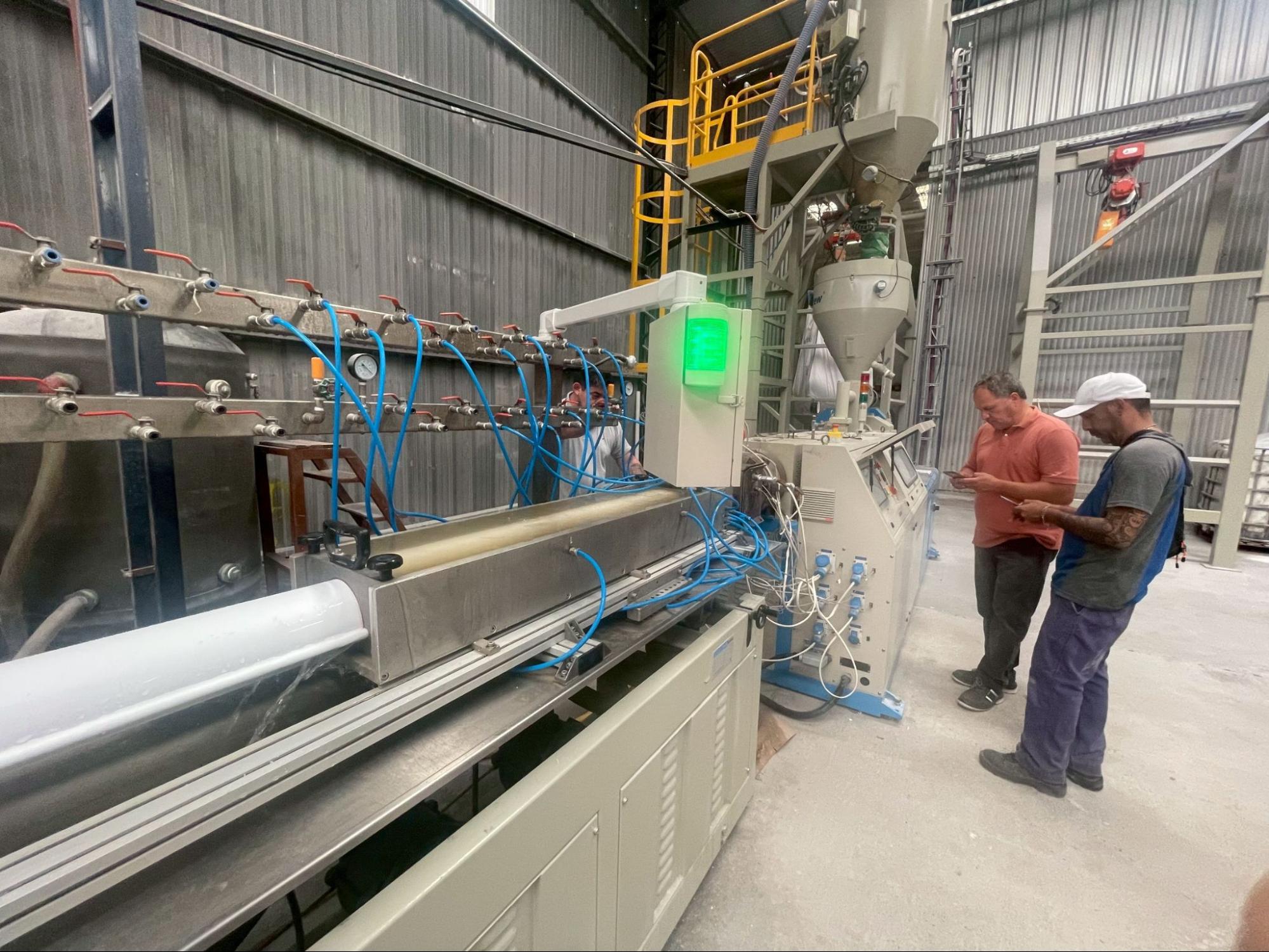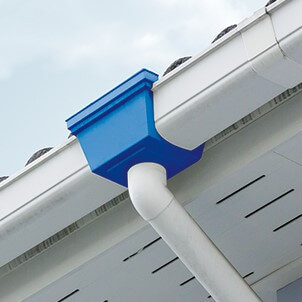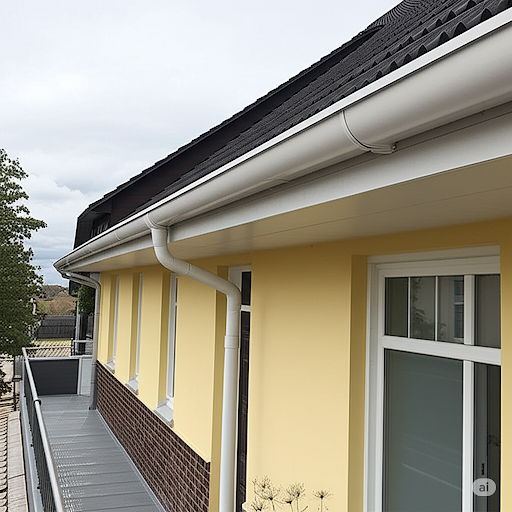Gutter Extrusion Machines: A Guide to Modern Plastic Gutter Manufacturing
- Gutter Extrusion vs. Roll Forming: Process Comparison
- 7 Reasons to Choose PVC Gutters
- Extruded PVC vs. Traditional Metal Gutters: A Performance Comparison
- Profiles & Applications: Gutter Shapes Enabled by Extrusion Technology
- Smart Manufacturing: The Future of Gutter Extrusion Technology
- How to Achieve Flawless PVC Gutter Production
- The Future of Gutters: Trends & Market Opportunities
- TwinScrew’s Commitment to Excellence in Extrusion Technology
- Frequently Asked Questions (FAQ)
- Ready to Elevate Your Gutter Manufacturing?
Gutters are essential for protecting building foundations and preventing water damage. While traditional metal gutters have long been the standard, their susceptibility to denting and corrosion has driven demand for better alternatives—chief among them, plastic PVC gutters. The demand for these advanced PVC systems has made gutter extrusion machines an indispensable tool in modern construction.
Unlike roll-forming machines for metal, extrusion machines melt plastic raw materials to produce continuous, seamless gutter profiles. This advanced manufacturing technology enables the creation of high-quality, durable, and aesthetically versatile PVC gutter systems, positioning manufacturers as leaders in the modern construction market.

Gutter Extrusion vs. Roll Forming: Process Comparison
Two core technologies dominate the world of gutter manufacturing: extrusion and roll forming. While both can produce continuous gutter lengths, the materials and processing methods differ significantly.
- Extrusion machines, such as those offered by TwinScrew, use high-temperature melting of plastic (PVC) to form seamless profiles. This makes them ideal for corrosion-resistant, lightweight, and customizable gutters.
- Roll forming machines are designed for shaping metal materials like aluminum, copper, or galvanized steel using progressive rollers. These machines are often used for seamless metal gutters fabricated on-site.
In comparison, extrusion is better suited for factory-scale, automated production and offers unmatched flexibility in design and finish. Its resistance to corrosion, ease of installation, and cost-effectiveness make it ideal for modern buildings, especially in humid or coastal climates.
To dive deeper into the technology, explore our 3-minute guide to PVC Twin Screw Extruders.

7 Reasons to Choose PVC Gutters
The true value of a gutter extrusion machine lies in its ability to produce PVC gutters with a host of practical advantages. These benefits, which are directly enabled by the precision of the extrusion process, have made PVC gutters increasingly popular among builders and homeowners. Here are seven key reasons:
-
Durability & Longevity
: Continuous sections resist buckling and rippling, ideal for cold, snowy regions. -
Flexibility & Impact Resistance
: PVC flexes without permanent damage, making it easier to repair and better suited for impact-prone areas. -
Cost-Effectiveness
: Lower initial cost, less maintenance, and easy repairs translate to a lower total cost of ownership. -
Ease of Installation
: Lightweight and snap-together designs simplify installation—even DIY projects. If you're interested in the full production line process, you can read our PVC Pipe Making Machine & Production Line : Start Smart, Scale Fast. -
Corrosion Resistance
: PVC does not rust or corrode, eliminating the need for repainting or extensive upkeep. -
Aesthetic Versatility
: Available in various colors and profiles, easily integrates into diverse architectural styles. -
Environmental Friendliness
: Often made from recycled materials, non-toxic, and fully recyclable.
All of these product-level advantages are made viable at scale through high-performance extrusion equipment, which can produce seamless, dimensionally consistent gutter sections with minimal defects and optimized production speed. This requires you to be Selecting the Right PVC Twin-Screw Pelletizing Extruder for Optimal Production.

Extruded PVC vs. Traditional Metal Gutters: A Performance Comparison
These material-level benefits translate directly into practical performance advantages over metal gutters in real-world installations.
Metal gutters, though durable, are prone to denting and rust. Their heavier weight makes them harder to install. PVC solves these issues with lightweight, flexible, and corrosion-resistant properties. Unlike rigid metals, PVC bends under pressure (e.g., from snow) without cracking or permanent deformation. This enhances durability and reduces maintenance needs, lowering lifetime costs.
Because these attributes depend on profile integrity, extrusion machines play a critical role in ensuring PVC gutters perform reliably across diverse environments—especially where precision and consistency are non-negotiable. If you want to learn more about different extruder types, this guide on 7 Must-Know Types of Twin Screw Extruders will be very helpful.
Profiles & Applications: Gutter Shapes Enabled by Extrusion Technology
Building on these advantages, extrusion technology also offers unmatched design versatility. The ability to create diverse shapes tailored to architectural and functional requirements further expands the appeal of PVC systems.
For manufacturers looking to invest in custom rain gutter extrusion solutions, flexibility in design and seamless output are top priorities.
TwinScrew’s extrusion machines enable precise, efficient production of various gutter profiles:
-
Popular Extruded Profiles:
- Half-Round
- K-Style
- Ogee
- Square-Shaped
-
Specialty Profiles Enabled by Extrusion:
- Funnel-Shaped
- Fluted Designs
- Decorative Patterns
- Box-Shaped (for commercial use)
The extrusion process allows for fast production of these designs at scale while maintaining tight dimensional tolerances and aesthetic quality. This is similar to the principles in the Beginner’s Guide to PVC Pelletizing Extrusion Lines.

Smart Manufacturing: The Future of Gutter Extrusion Technology
But producing these varied and high-performance profiles consistently requires more than just good materials—it demands next-generation technology and smart automation.
As demand grows for automated gutter extrusion lines that support Industry 4.0 integration, modern systems must offer real-time monitoring, predictive maintenance, and fast profile changeovers. If you also want to know How to Choose the Best PVC Pipe Extrusion Line : Tips and Factors, this article provides excellent insights.
TwinScrew is leading the shift toward smart, automated manufacturing systems that boost production quality and efficiency:
- PLC Controls(PID)
- Servo Motors
- Modular Design
- Energy Efficiency
These features not only ensure consistent gutter quality but also future-proof your factory with Industry 4.0 capabilities.
How to Achieve Flawless PVC Gutter Production
In addition to automation, maintaining flawless output requires addressing and preventing common extrusion defects at every stage of production.
TwinScrew’s extrusion technology addresses common production defects:
- Melt Fracture
- Voids & Air Traps
- Dimensional Inaccuracy
- Poor Surface Finish
- Warping
- Extruder Stops
- Temperature Variations
The die is the heart of the extrusion line. TwinScrew's in-house die engineering ensures uniform flow, optimal temperature management, and consistent product quality with fewer rejects. This is equally important for a Medical Tube Extrusion Line : Key Insights and Case Studies.
The Future of Gutters: Trends & Market Opportunities
As the industry becomes more competitive, understanding these technical foundations is key—but staying ahead also means recognizing where the market is heading.
The global plastic gutter market is growing rapidly, driven by:
- Urbanization & Construction Growth
- Increased Focus on Water Management
- Demand for Sustainable, Low-Maintenance Products
- Preference for Seamless, Custom-Fit Systems
-
Emerging Trends:
- Seamless Gutter Designs
- DIY-Friendly Systems
- Smart Integration
- Rainwater Harvesting
- Architectural Customization
TwinScrew’s extrusion systems are built to adapt to these trends, helping manufacturers offer innovative and high-margin solutions in a competitive market.
TwinScrew’s Commitment to Excellence in Extrusion Technology
Ultimately, the success of any gutter system hinges on both the technology behind it and the partner you choose.
With over 30 years of twin-screw innovation, TwinScrew has delivered 3,000+ machines across 150+ production lines in 40+ countries. This is the kind of professionalism emphasized in Medical Tube Extrusion 101 : A Guide to Essential Machinery and Processes.
Success Story:
A mid-sized manufacturer in South America—serving key markets in Argentina and Brazil—adopted TwinScrew’s PVC gutter extrusion system. Within 6 months, they increased output by 25%, reduced material waste, and added new rainwater harvesting profiles—gaining market leadership in their region.
We offer more than equipment—we offer expertise, partnership, and the technology needed to lead in the growing plastic gutter market.
Frequently Asked Questions (FAQ)
Q1: What is a gutter extrusion machine used for?
A gutter extrusion machine is designed to produce seamless, continuous rain gutters from plastic materials such as PVC.
Q2: How does gutter extrusion compare to roll forming?
Gutter extrusion is mainly used for PVC, while roll forming is used for metals. Extrusion offers better flexibility, seamless profiles, and corrosion resistance.
Q3: Are extruded PVC gutters better than traditional metal gutters?
In many applications, yes. They're easier to install, don’t rust, and cost less, especially when made with modern extrusion systems.
Q4: What are the most common PVC gutter profiles produced by extrusion machines?
Half-Round, K-Style, Ogee, Square, and Box-Type. Advanced machines also support custom decorative or water-harvesting designs.
Q5: What should I consider before buying a gutter extrusion machine?
Look at profile types, raw material format, production speed, die design flexibility, automation level, and support services. TwinScrew helps tailor systems to your needs.
Ready to Elevate Your Gutter Manufacturing?
In an evolving market where performance and design flexibility are paramount, the shift from traditional materials to advanced PVC gutters is no longer a trend—it’s a necessity for market leadership. Our comprehensive guide has shown how high-performance extrusion technology is the key to unlocking the full potential of these durable, cost-effective, and aesthetically versatile systems.
At TwinScrew, we don't just supply state-of-the-art machinery; we provide a strategic partnership that ensures your factory is future-ready. Our commitment to innovation, from in-house die engineering to smart manufacturing integration, empowers you to produce flawless gutters and capitalize on emerging market opportunities. As demonstrated by our successful partnerships worldwide, we are dedicated to helping you achieve not just growth, but sustainable excellence.
Contact us today to begin a conversation with our expert team about how a customized extrusion solution can elevate your manufacturing process and position you as a leader in the modern construction industry. Your future in gutter manufacturing starts here.
Related Articles



